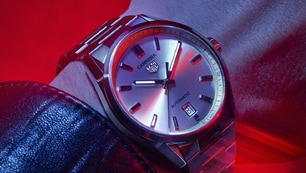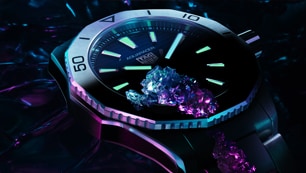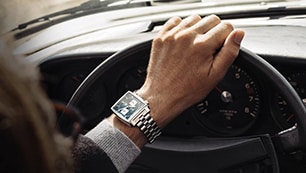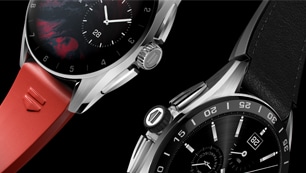SUMMARY
Introduced in 1962, the Autavia chronograph had features that made the chronograph popular over its two decades of production. Racers, pilots and other adventurers enjoyed the legibility provided by the Autavia, the large size of the watch, and the waterproof case that ensured durability for the most demanding missions. The rotating bezel provided an additional tool for these adventurers, as well as travelers, divers and scientists.

Heuer had been producing chronographs for almost 50 years when, in 1962, the company took an entirely new approach to the design and marketing of these timepieces. This would be the first new chronograph introduced under the leadership of the company’s 29 year-old President, Jack Heuer, and he brought bold innovations to the catalog of chronographs, as he had with the company’s stopwatches and dashboard timers.
Most noticeably, whereas its previous chronographs had been identified only by their model numbers (for example, reference 2447 or reference 346), Heuer would now use model names to identify its chronographs, and the first to appear in the catalog was a fine one, “Autavia”. From 1933 through the mid-1950s, Heuer had used “Autavia” as a model name for its 12-hour, dashboard mounted stopwatches. Indeed, these rugged timers were ideal for AUTomobile and AVIAtion applications. Now, with the Autavia timer being replaced by the new “Monte Carlo” 12-hour stopwatch, the name could be used for the new chronograph that Heuer introduced in 1962.
But the new name was only the start of what made the Autavia a revolutionary chronograph. For the first time, Heuer would fit one of its chronographs with a rotating bezel, a particularly useful tool for racing, flying and many other sports and industrial applications. As described by Jack Heuer in his autobiography,
“In the autumn of 1961 I decided with my production team to create a new “Autavia” as a wrist chronograph. Until then we had never added a turning bezel to one of our wrist chronographs. We therefore designed this new “Autavia” to have a turning black bezel with a choice of division markers. A bezel with 60 separate one-minute divisions, for example, would allow the wearer to set a marker for a defined interval of less than one hour; a 12-hour division would allow the time in another time zone to be displayed; and divisions of 1/100th of a minute would be useful for time study purposes.”
Indeed, the rotating bezel would provide the user of the Autavia with a variety of additional timing capabilities and all Autavia chronographs would have this feature. For a description of the variety of bezels used on the Autavia, see more on The Edge.
The design of the Autavia chronograph’s dial and hands represented a third innovation for the new chronograph. While Heuer’s previous chronographs used monochromatic dials, with the registers always matching the color of the dial, the Autavia featured bright white registers on the matte black dial. These registers were oversized, to ensure optimal legibility for the racer or pilot. The hands were also a fresh design for the new Autavia, being dauphine shaped and covered entirely with radium.
Yes, having the name “Autavia” printed on the dial announced that Heuer was creating a new style of chronograph, but the company went far beyond that cosmetic change, to offer an entirely new style of chronograph.

OVERVIEW OF THE AUTAVIA CHRONOGRAPH (1962 to 1983)
Heuer introduced its first Autavia chronograph in 1962 and offered over 80 different versions of the watch over the next two decades, with the last models introduced in 1983. While the long list of models, movements, cases and other variations can be daunting, it becomes more manageable when we break the models of the Autavia chronograph into three generations. The first generation of the Autavia chronograph (1962 through 1967) used round, screw-back cases, with manual winding movements. The second generation (1967 through 1972) used a snap-back case referred to as a “compressor” case, with manual winding movements. The third generation of Autavia chronographs (1969 through 1983) used C-shape cases, with a variety of automatic and manual winding movements.
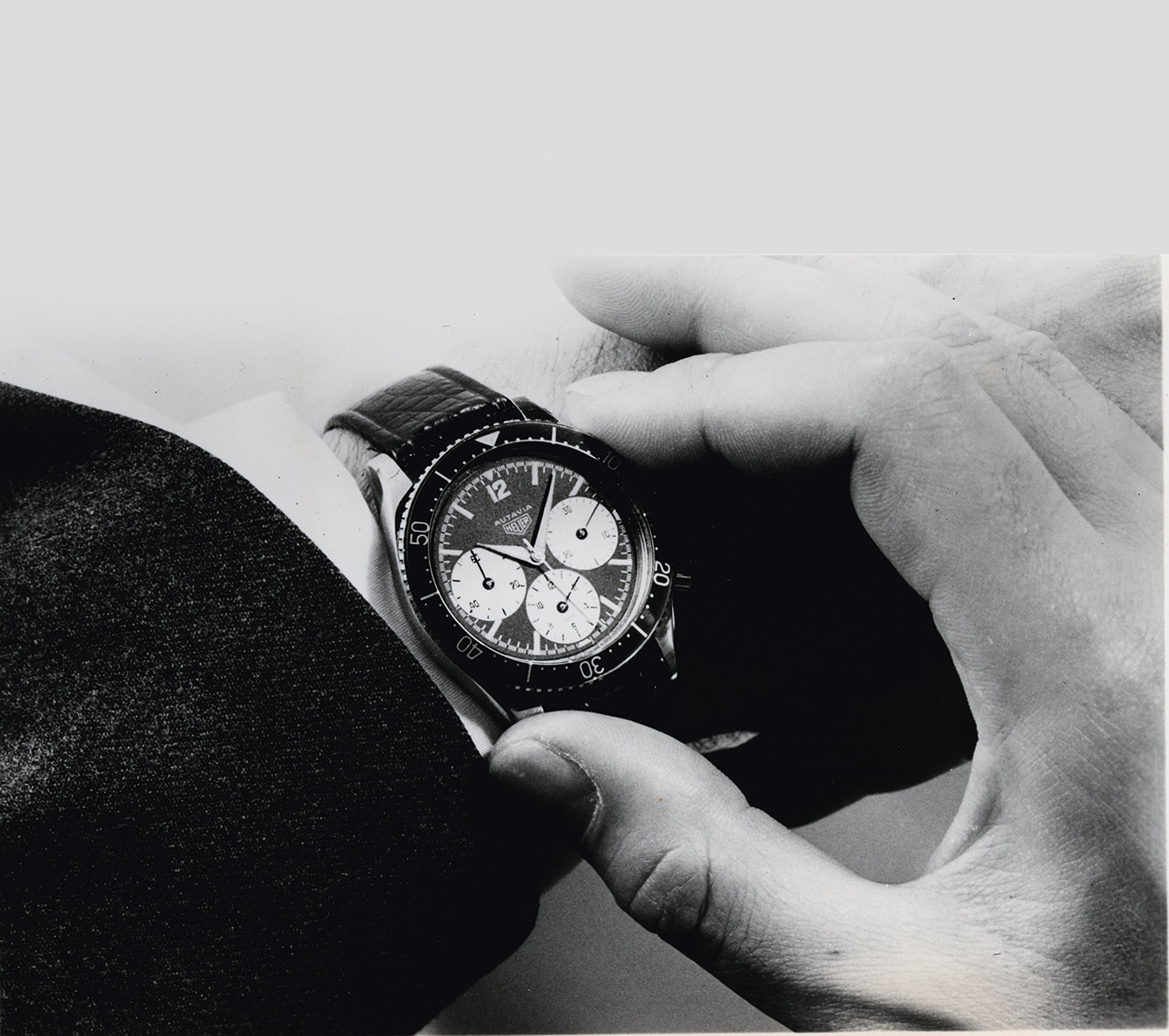
FIRST GENERATION AUTAVIA – SCREW-BACK CASE
The first of the Autavia models from 1962 is perhaps the purest of the serie, a classic 38mm steel case with simple black dial, painted lume hour markers and “12” and “6” numerals, and oversized white sub-dials (which collectors call “Big Subs”). There’s not one superfluous detail on the dial, every feature is there for a reason. The hands on the first Autavia chronographs are dauphine shaped, with the earliest models having hands that are covered entirely in luminous material (now called “All Lume” hands) and the next hands being metal-plated, with luminous paint at the center of the hands.
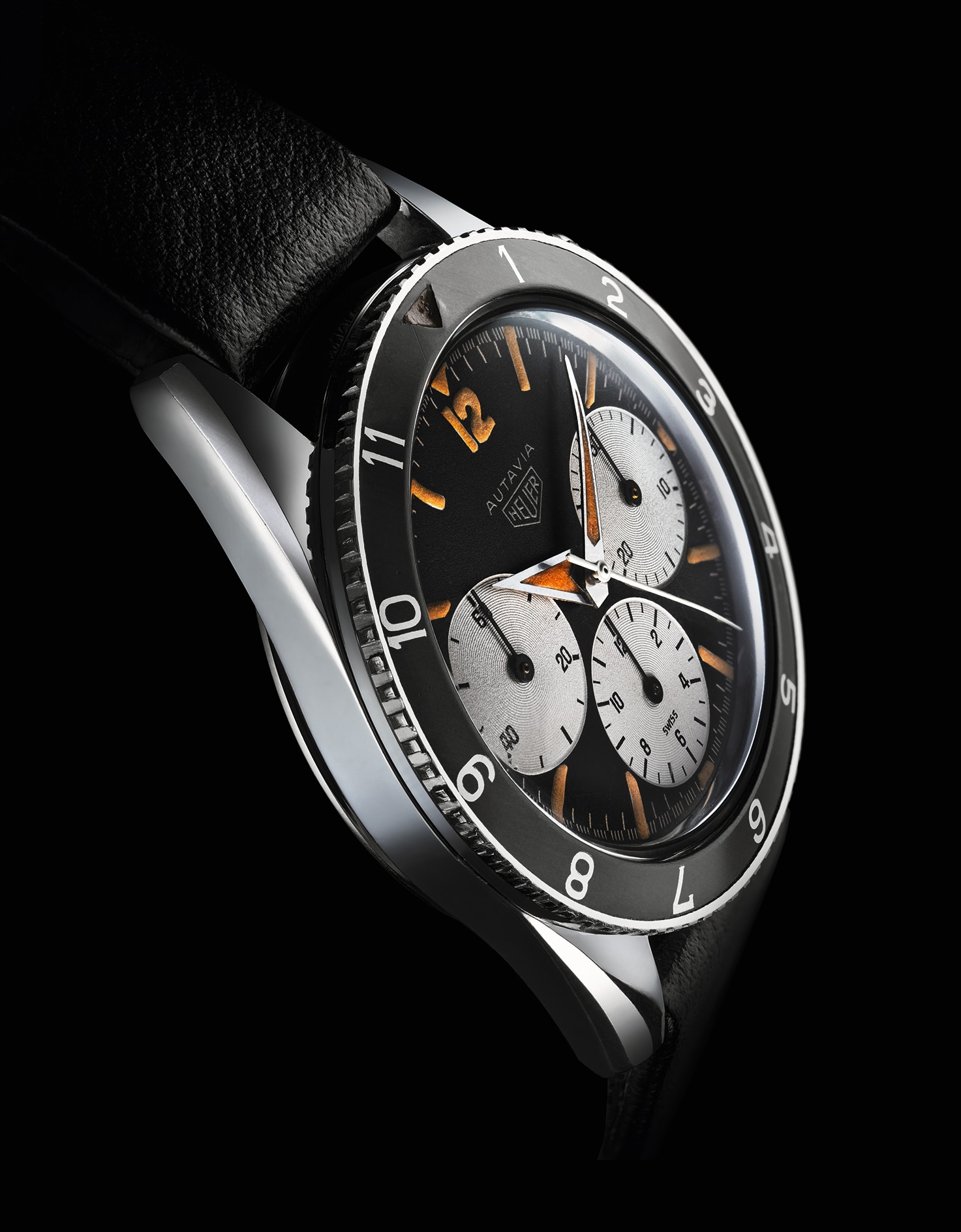
The case uses a screw-back construction, with the back marked with the “Heuer” shield and “Autavia” name, as well as “Waterproof – Guaranteed 330 Feet Under Water”. The use of waterproof cases would be another defining feature of the Autavia chronograph, continuing through the production life of the model.
The geometry of the Autavia screw-back case would change slightly in 1966, as the bezel became narrower (with the “second execution” screw-back case), but the more significant changes came in the style of the dial and hands.
- The dial had smaller white registers, with applied metal hour-markers
- Hands are metal-plated, stick-shaped, with luminous infill
- Smaller white sub-dials
MOVEMENTS
There were only three models in the initial Autavia range, each of which used a different Valjoux calibre. All were manual-wind chronograph movements and it’s quite easy to tell which movement is inside one of these early models, based on the number of registers.
- Valjoux 72 - three register manual-wind chronograph (reference 2446)
- Valjoux 92 - two register manual-wind chronograph (reference 3646)
- Valjoux 724 - GMT version of Valjoux 72 (reference 2446 GMT)

SECOND GENERATION AUTAVIA – COMPRESSOR CASE
Since the early 1960s, Heuer had been using a patented type of snap-back case for some of its dive watches, with the case-back being opened using a special tool and then closed with a press, and offering improved waterproofing. In adopting this type of “compressor’ case for the Autavia, Heuer redesigned the case from top to bottom, with the soft, flowing lugs of the first generation models being replaced with square edges, best illustrated by the comparison below.
The second-generation Autavia was only on sale for less than two years (1968-69). but the dial and hands themselves went through two executions. The first execution dial was entirely black and white, and was paired with simple “stick” hands. The second execution dial used more complex applied markers, with the hands incorporating painted black stripes, and red was introduced as an accent color for the dial and chronograph second hand. This color scheme would continue through the life of the Autavia, for the next 15 years.
While the Autavia had introduced the GMT complication toward the end of the first generation models (circa 1967), the Autavia GMT was a popular model throughout production of the second generation “compressor” models.
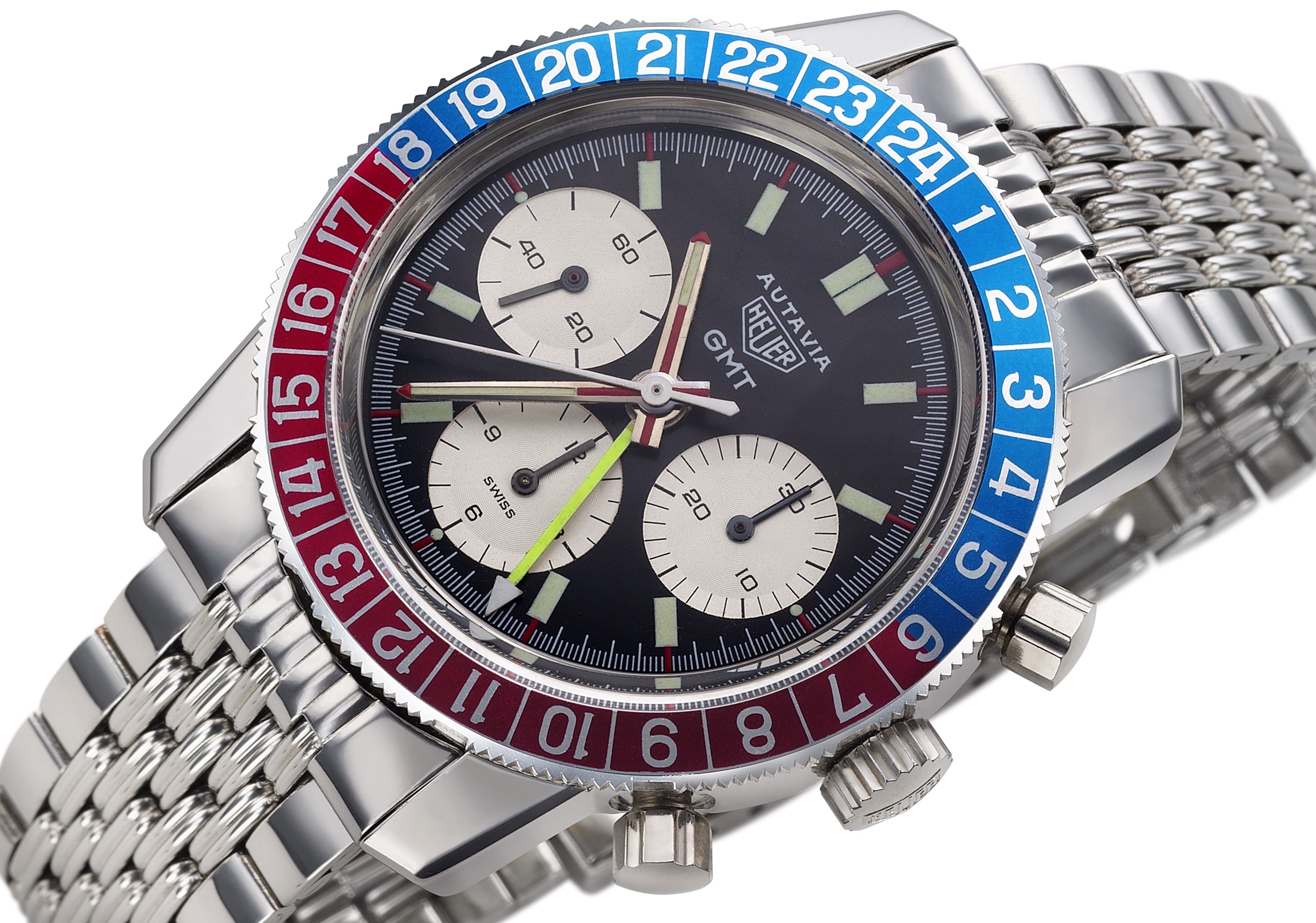
MOVEMENTS
The second generation Autavia expanded the number of movements offered, firstly replacing the Valjoux 92 with the newer Valjoux 7730.
- Valjoux 72 - three register, as used in the first generation (reference 2446C)
- Valjoux 7730 - two register (reference 7763C)
- Valjoux 7732 - two register with date (reference 7863C)
- Valjoux 724 - three register GMT, as per first generation (reference 2446C GMT)
THIRD GENERATION AUTAVIA – C-SHAPE CASE
While the cases used for the first and second generation Autavia chronographs were based on traditional round cases, the third generation Autavia case, launched in 1969, was as revolutionary as the movement that it was designed to house. With Heuer’s new automatic chronograph movements being larger than the previous manual-winding movements, the C-Shape case proved to be the ideal housing for Heuer’s versions of the Autavia and Carrera automatic chronographs.
The third generation Autavia was introduced in 1969 and continued through the last version of the Autavia in 1983, and is made up of four sub-series:
- reference 1163
- reference 11630
- reference 11063
- colored cases – reference 11X.603
The centerpiece of the new range was the Chronomatic movement (Calibre11 and later Calibre 12), Heuer’s own automatic chronograph movement instantly recognisable with the crown on the left hand side of the case.

AUTAVIA REFERENCE 1163
The reference 1163 Autavia (“11” denoting the Calibre, although Heuer did not change the reference number as it evolved the Calibre 11 to the Calibre 12, and “6” for the Autavia series) was launched in 1969 and has the 1163 reference number engraved between the lugs. The bulk of the 1163 range was offered from 1969-1972, although some models, such as the 1163V were sold through to the early 1980s. From the time the larger-cased reference 11630 Autavia arrived in 1972, the reference 1163 case was mainly used for manual-wind versions.

The reference 1163 Autavia measures 42.5 millimeters across the dial and is distinguished by:
- Bi-directional bezel- most models have a silver triangle at 12 and no lume dot
- Plastic domed crystal
- Cut-outs in the top of the case that allow the pushers to be seen “head on”
Among the famous 1163 models was the 1163V, the “Viceroy” model, exemplified by its black dial with white registers, and red accents, which could be bought for $88 back in 1972, if the customer provided proof of purchase for 10 packs of Viceroy cigarettes. The Reference 1163T has a white dial with black chronograph registers, and blue accents, and was the choice of Swiss Formula 1 racer Jo Siffert (so that this color scheme is called the “Siffert” Autavia by enthusiasts). Collectors use the name “Orange Boy” for the rare version of the reference 1163 Autavia that has orange accents on the dial and hands.
While the 1163 was only on sale for a few years, the design of the case served as the template for all Autavia models that followed.

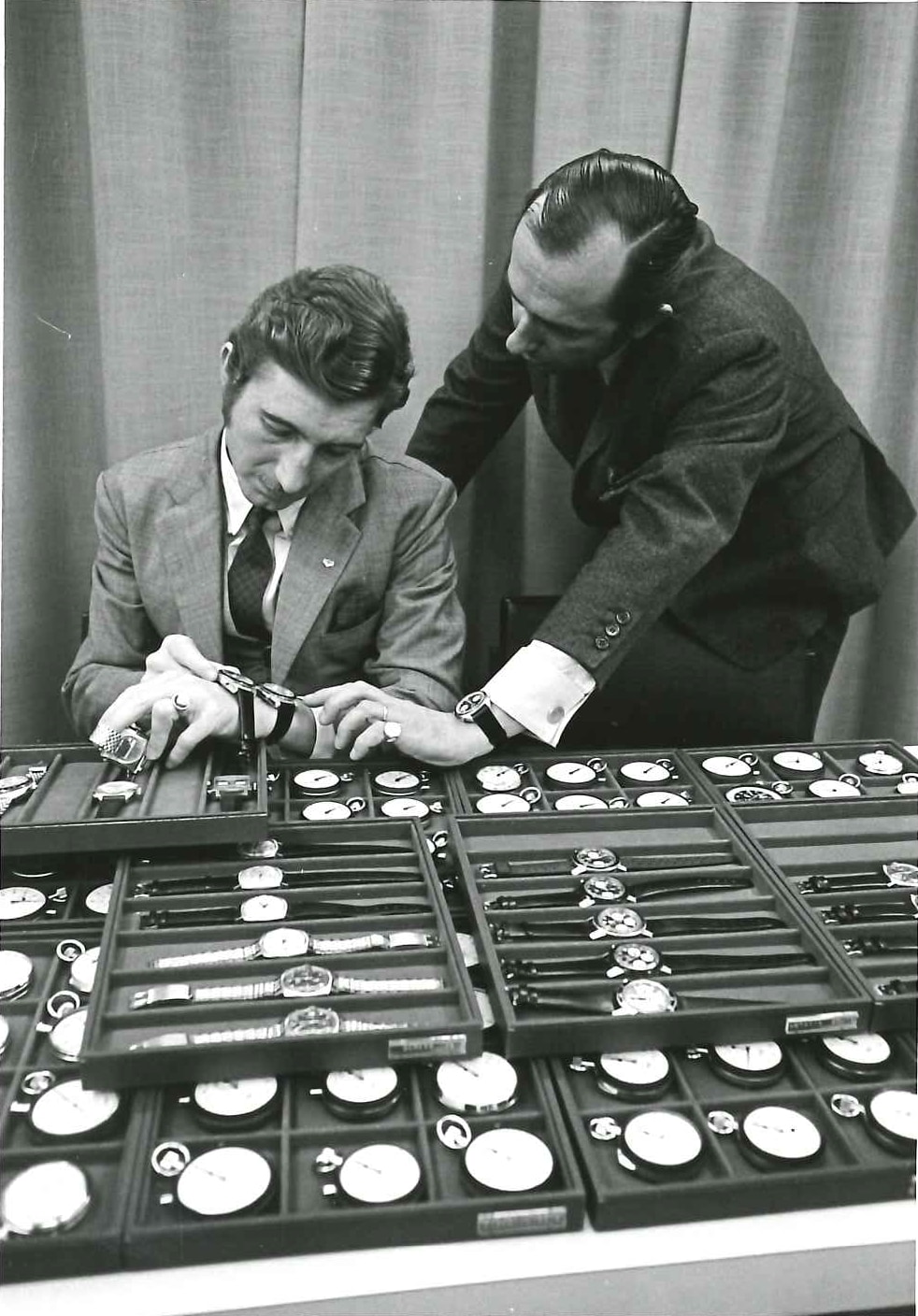
Reference 1563
In 1972, Heuer modified the Calibre 12 movement so that it could offer more affordable chronographs. In the Calibre 15 movement, Heuer deleted the hour recorder, but added a running seconds hand at 10 o’clock, so that the dials are asymmetrical.
Most notable of the Calibre 15 Autavias is the reference 1563 “Exotic”, which has oversized lume markers, a hash-mark track showing minutes and 1/5 seconds, and bright orange hands and accents, to complete the psychedelic look of the 1970s.
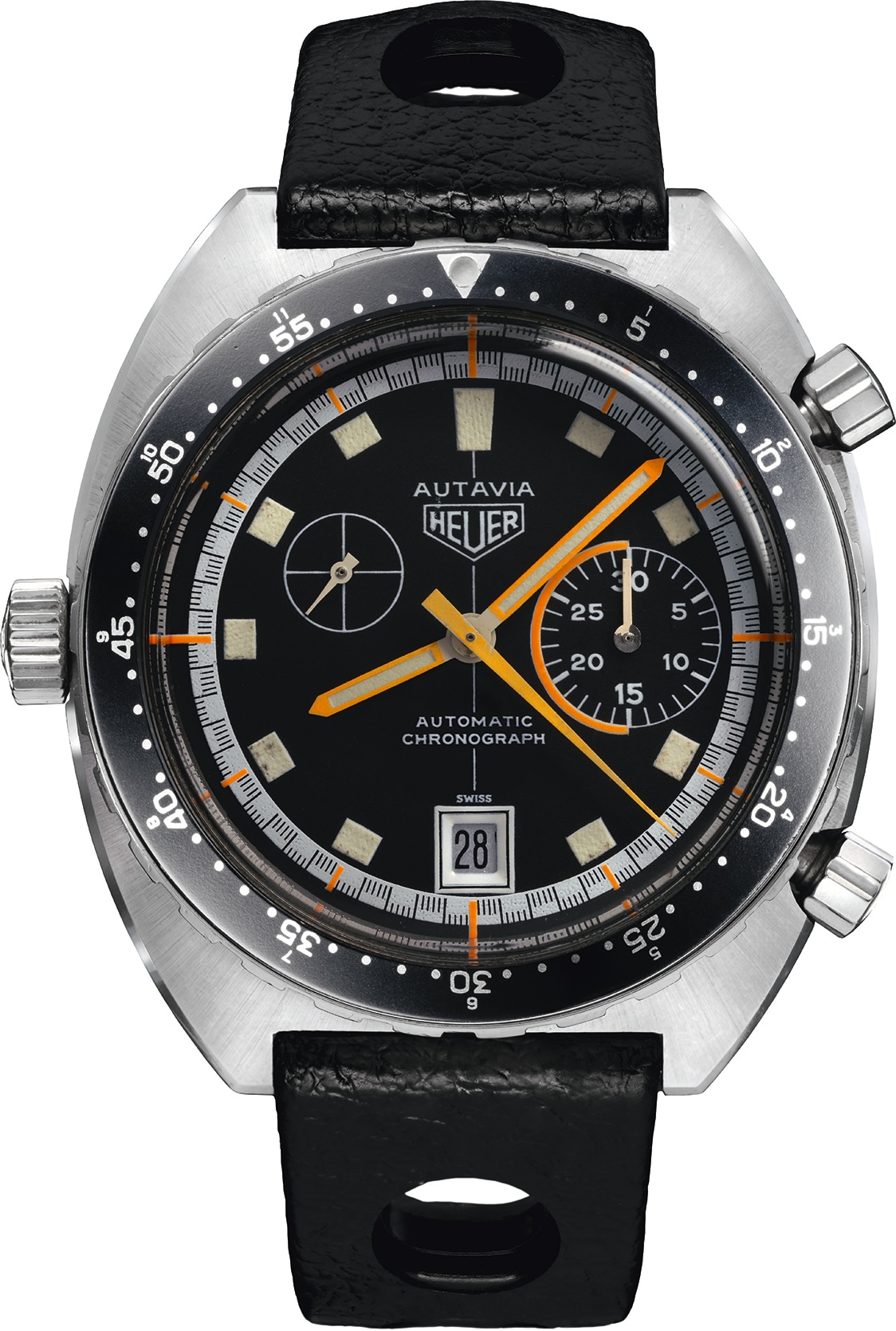
MANUAL-WIND
While the purpose of the C-Shape case was to provide appropriate housing for Heuer’s new automatic movements, Heuer also offered a broad range of manual-wind movements in the early 1970s using the C-Shape case.
The Autavia reference 73363 offered two registers (30-minute capacity); the Autavia reference 73463 had two registers (30-minute capacity), plus a date; the Autavia Reference 73663 had three registers, including both a 12-hour chronograph and running seconds; and the Autavia Reference 741603 has two registers (chronograph minutes and hours), with a date.
While many of the third generation, manual winding Autavias incorporated the colors and styles of the automatic models (for example, the “Viceroy” and “Siffert” colors), Heuer added specific models that incorporated pilots or military styles.
These manual-wind Autavia models were introduced in 1972, as the automatic reference 1163 Autavia models were phased out, and continued in the range through the mid-1970s.

AUTAVIA REFERENCE 11630
In late 1972, Heuer introduced a new version of the Autavia (reference 11630) that was built to use a mineral crystal. While the 42.5 millimeter measurement across the dial is the same as the reference 1163 predecessor, the construction of the case (with a deep black flange between the dial and the crystal) gave the new Autavia a heftier look and feel. Key specifications of the reference 11630 Autavia include:
- Flat, wider bezel (still bi-directional)
- Covered pushers, no longer visible from the front of the case
- Flat Mineral glass
- Lume dot at 12 o’clock in the silver triangle
- 11630 engraved between the lugs
All models used the Calibre 12 or Calibre 15 family of automatic movements
Autavia 15630
The only variant of the reference 11630 Autavia is the Calibre 15 version, the reference 15630. One model has a black dial with a black minute register and another has a silver dial, with a black recorder, with both models having bright orange time-of-day hands and orange accents on the dial.
AUTAVIA 11063
Heuer introduced its final case for the Heuer Autavia in 1983. Two of the significant changes in the new model relate to the bezel, with the geometry being change to create large “teeth”, making it easier to grip, and the bezel now being unidirectional, as preferred by divers. While the case remained 42.5 millimeters across the dial, the width between the lugs was increased from 20 to 21 millimeters, giving the watch a more substantial look.
AUTAVIA COLORED CASES – REFERENCE 11X.603
The very last Heuer Autavia series was the 11X.603 launched in 1985, a family of four models using the 11063 case, but with color-coated finishes. The full range was:
- Reference 111.603- Olive coated
- Reference 112.603- Pewter coated
- Reference 113.603- Black coated
- Reference 114.603- Gold coated
For each of the four models, the color of the dial matches the color of the case, the hands are white-edged (for the black and olive models) or black-edged (for the pewter and gold models), and “racing stripes” on the chronograph minute recorder match the color of the hands.
The case back is also unique to this model and very similar to that used on the first generation of TAG Heuer models.
NAUTICAL AUTAVIA MODELS
With its excellent waterproof and rotating bezel, the case used for the Autavia chronograph served as an excellent host for other models made by Heuer over the years. Here, we provide a brief overview of the models of the Heuer Mareographe (Abercrombie & Fitch Seafarer), Heuer Regatta and Heuer Skipper that have used Autavia cases.
HEUER MAREOGRAPH
Circa 1950, Heuer introduced a three register chronograph that featured a dial that would indicate the times for the high and low tides at a specific location. The chronograph minute recorder was marked in five-minute segments, so that it was useful for the countdown to the start of a yacht race. These chronographs were sold under the Heuer Mareographe name, and Heuer also produced them on a private label basis for Abercrombie & Fitch, using the “Seafarer” model name, and for Orvis, which used the Solunagraph name.
The waterproofing offered by the Autavia case was excellent for these chronographs, so that Autavia cases were used for the Mareographe circa 1962 (the reference 2446 case), as well as the compressor cases (reference 2446C) from the late 1960s into the early 1970s.
HEUER REGATTA
Introduced in 1964, the Heuer “Regatta” used a series of colored discs to count down the time (5 or 10 minutes) to the start of a yacht race. The last version of the Regatta, introduced in 1983, used the colored cases of the Autavia, for black, olive green and pewter versions of the Regatta.
HEUER SKIPPER
To celebrate the role of Heuer as supplier to the yacht racing team that defended the America’s Cup yacht race in 1967, Heuer introduced the “Skipper” model chronograph in 1968. The chronograph minute recorder of the Skipper was marked in five-minute segments to allow the captain to count down to the start of a yacht race. The first version of the Skipper (from 1968) was housed in the case from a Carrera chronograph, but all subsequent models of the Skipper were housed in cases for the Autavia, which offered better waterproofing. Skipper chronographs housed in Autavia cases started with the reference 2446C compressor case and continued through the reference 1163, 11630 and 11063 C-Shaped cases.
BRACELETS FOR THE AUTAVIA
The first generation Autavias, which used traditional round screw-back cases, were sold on the proprietary artificial leather straps, known as “Corfam”. Over its two decades of production, the Autavia chronograph was offered on a variety of straps, but the “grains of rice” bracelets manufactured by Gay Freres (GF) are favored by many of today’s collectors. Here is an overview of some of the GF bracelets that were used for the Autavia:
- First generation: Gay Freres double grain bracelet- End pieces- HL (19mm)
- Second generation: Gay Freres double grain bracelet- End pieces- HLB (20mm)
- Third generation reference 1163: Gay Freres single grain bracelet- HLF (20mm)
- Third generation reference 11630: Gay Freres single grain bracelet- HLD (20mm)
- Third generation reference 11063 and colored cases (reference 11X.603): Jubilee bracelet (21mm)

